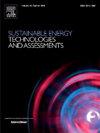Evaluating the potential of oil seed extract ashes from niger, cotton, and flaxseed as sustainable supplementary cementitious materials
IF 7.1
2区 工程技术
Q1 ENERGY & FUELS
Sustainable Energy Technologies and Assessments
Pub Date : 2025-04-01
DOI:10.1016/j.seta.2025.104285
引用次数: 0
Abstract
This study evaluates the potential of oil seed extract ashes (OSAs) from niger, cotton, and flaxseed, as a supplementary cementitious material (SCM) in cement mortar applications. The pozzolanic reactivity of niger and flaxseed OSAs was assessed through compressive strength tests, with results showing 28-day strengths of 40.74 MPa and 43.36 MPa, respectively, achieving 85–90% of OPC at 48.73 MPa. Workability tests revealed slight reductions in flow diameters for niger (115 mm) and flaxseed (110 mm) OSAs compared to OPC (118 mm), indicating denser particle packing. In contrast, cotton OSA exhibited a higher flow of 140 mm. Cotton OSA lacks pozzolanic activity compared to niger and flaxseed due to the absence of CaO and Al2O3, along with very low SiO2. Cost analysis demonstrated a 7.6–9.2% reduction in material costs, with niger-based mortar priced at INR 5504/m3 and flaxseed-based mortar at INR 5605/m3, compared to OPC at INR 6065/m3. CO2 emissions were reduced by 19%, with niger and flaxseed OSA mortars emitting 401 kg CO2/m3 and 400 kg CO2/m3, respectively, compared to 494 kg CO2/m3 for OPC. The microstructural characterization of these OSAs by FESEM, XRF, XRD, FTIR, Raman, and TGA confirms that these materials present viable, cost-effective, and eco-friendly alternatives to OPC as SCMs.
评价尼日尔、棉花和亚麻籽的油籽提取物灰作为可持续补充胶凝材料的潜力
本研究评估了尼日尔、棉花和亚麻籽的油籽提取物灰(OSAs)作为水泥砂浆补充胶凝材料(SCM)的潜力。通过抗压强度试验,评价了黑籽和亚麻籽氧化胶的火山灰反应性,结果表明,28天强度分别为40.74 MPa和43.36 MPa,在48.73 MPa时达到OPC的85-90%。可加工性测试显示,与OPC(118毫米)相比,尼日尔(115毫米)和亚麻籽(110毫米)osa的流动直径略有减少,表明颗粒堆积更密集。相比之下,棉花OSA的流量更高,为140 mm。与黑籽和亚麻籽相比,由于缺乏CaO和Al2O3,以及非常低的SiO2,棉花OSA缺乏火山灰活性。成本分析表明,与OPC的6065卢比/立方米相比,尼日尔基砂浆的价格为5504卢比/立方米,亚麻籽基砂浆的价格为5605卢比/立方米,材料成本降低了7.6-9.2%。二氧化碳排放量减少了19%,黑色和亚麻籽OSA迫击炮的排放量分别为401 kg CO2/m3和400 kg CO2/m3,而OPC迫击炮的排放量为494 kg CO2/m3。通过FESEM、XRF、XRD、FTIR、Raman和TGA对这些osa进行了微观结构表征,证实了这些材料是OPC作为scm的可行、经济、环保的替代品。
本文章由计算机程序翻译,如有差异,请以英文原文为准。
求助全文
约1分钟内获得全文
求助全文
来源期刊

Sustainable Energy Technologies and Assessments
Energy-Renewable Energy, Sustainability and the Environment
CiteScore
12.70
自引率
12.50%
发文量
1091
期刊介绍:
Encouraging a transition to a sustainable energy future is imperative for our world. Technologies that enable this shift in various sectors like transportation, heating, and power systems are of utmost importance. Sustainable Energy Technologies and Assessments welcomes papers focusing on a range of aspects and levels of technological advancements in energy generation and utilization. The aim is to reduce the negative environmental impact associated with energy production and consumption, spanning from laboratory experiments to real-world applications in the commercial sector.
 求助内容:
求助内容: 应助结果提醒方式:
应助结果提醒方式:


